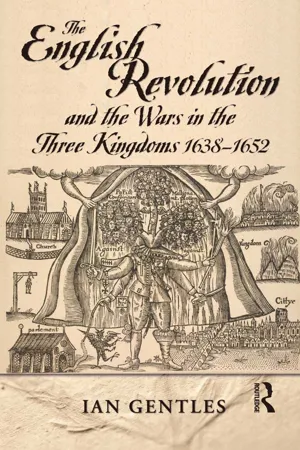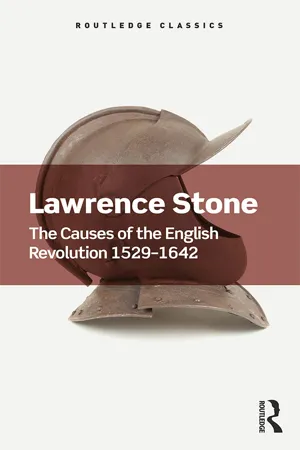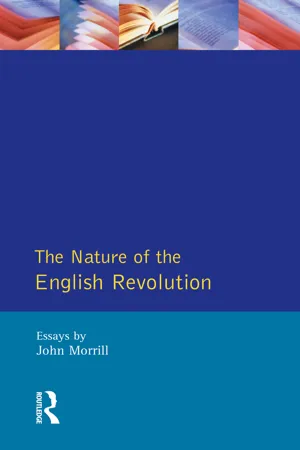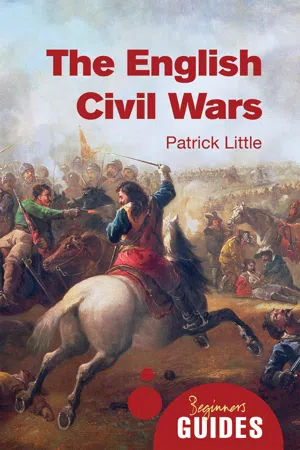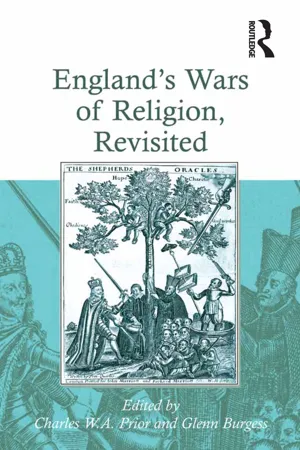History
The English Civil War
The English Civil War was a series of armed conflicts and political machinations between Parliamentarians and Royalists in the 17th century. It resulted in the execution of King Charles I and the establishment of the Commonwealth under Oliver Cromwell. The war had a profound impact on the development of the English constitution and the shift of power from the monarchy to Parliament.
Written by Perlego with AI-assistance
Related key terms
6 Key excerpts on "The English Civil War"
- eBook - ePub
The History of Democracy
A Marxist Interpretation
- Brian S. Roper(Author)
- 2012(Publication Date)
- Pluto Press(Publisher)
As this suggests, the English Revolution was by no means simply and exclusively a revolutionary upheaval directed against absolutism and for democracy. It centrally involved the revolutionary assertion by a minority of the aristocracy and upper gentry, together with a majority of the staunchly protestant ‘middling sort’ of the people, of the rights and role of Parliament in governing England against the absolutist aspirations and catholic sympathies of Charles I (Manning, 1991; 1996: 6–11). But constitutional and political considerations only formed one part of a complex and dynamic array of closely interwoven issues encompassing political and constitutional reform, fiscal policy, ecclesiastical reform and religious divisions, social and economic questions (popular revolt, the sanctity of property rights, resistance to enclosure, taxes and tithes), English policy towards Ireland and Scotland and the mutually interactive impacts of events in the three kingdoms, England’s foreign policy with respect to the other European powers, and military strategy, tactics and logistics in the various wars from 1642 to 1690.This chapter provides a chronologically organised description of the social context, historical backdrop and main events in England during the seventeenth century, not only to highlight the revolutionary nature of these events, and the role played by class forces in the revolution, but also to highlight the extent to which it ultimately created a system of government that was substantially more democratic by the 1690s than that which prevailed during the 1630s.THE ENGLISH REVOLUTION AND CIVIL WAR, 1640–59 English society in the mid-seventeenth century: population, class, gender and religionIt is important to have a sense of the scale and structure of English society in the seventeenth century. The population at this time was small compared with the present day. According to the Cambridge group’s estimates, it increased from 2.3 million in 1522–3 to 2.774 million in 1541, 4.110 million in 1601 and 5.281 in 1656 (Coward, 2003: 8).13 - I.J. Gentles(Author)
- 2014(Publication Date)
- Routledge(Publisher)
Yet even as late as the beginning of 1642 civil war was not inevitable. Had things gone a little bit differently Charles might well have defeated the Scots in the first Bishops’ War, thereby obviating the need to summon parliament in the autumn of 1640. 19 When parliament met, the king made huge political, financial and religious concessions to his critics. Most people who backed either the king or parliament, as well as the great majority of the population, who were interested mainly in local issues, had no desire for armed conflict. 20 Almost from the beginning the revisionist account of the reasons for England’s civil war came in for searching and sustained criticism. Revisionists were accused of doing a better job of explaining why a civil war did not happen rather than why it did. They were charged with exaggerating the extent of intellectual consensus in early Stuart England, while overlooking the substantive ideological differences between the king and his political opponents. Far from caring only about local, county matters, many people outside London had a lively interest in national issues, and were avid readers of political news from the capital, as well as the continent. The provinces were just as deeply divided over politics and religion – popery in particular – as was the metropolis. Not only was most of the country gripped by a terrible fear of international Catholicism, there was great resentment against the absolutist pretensions of the Stuart monarchy. Arbitrary arrest and imprisonment, unparliamentary taxation, and the king’s claim to be above the law were all deeply divisive issues in the decades leading up to the outbreak of civil war. Ann Hughes, Norah Carlin and others have argued that the civil war was also the product of broad social and cultural conflict. It is therefore unsatisfactory to explain the outbreak of civil war merely through a detailed narrative of high politics- eBook - ePub
- Lawrence Stone(Author)
- 2017(Publication Date)
- Routledge(Publisher)
Part II InterpretationPassage contains an image
3 The Causes of the English Revolution
1. Presuppositions
Before advancing an explanation for a historical event, it is first necessary to establish what kind of event it is which needs explaining. What happened in England in the middle of the seventeenth century? Was it a ‘Great Rebellion’ as Clarendon believed, the last and most violent of the many rebellions against particularly unprepossessing or unpopular kings that had been staged by dissident members of the landed classes century after century throughout the middle ages?1 Was it merely an internal war caused by a temporary political breakdown due to particular political circumstances? Such is the view of Miss C. V. Wedgwood, who is content to begin her history of The English Civil War in 1637, three years before the collapse of the government, and five years before the outbreak of armed violence.2 Was it the Puritan revolution of S. R. Gardiner, to whom the driving force behind the whole episode was a conflict of religious institutions and ideologies?3 Was it the first great clash of liberty against royal tyranny, as seen by Macaulay, the first blow for the Enlightenment and Whiggery, a blow which put England on the slow road to Parliamentary monarchy and civil liberties?4 Was it the first bourgeois revolution, in which the progressive and dynamic elements in society struggled to emerge from their feudal swaddling clothes? This is how Engels saw it, and how many historians of the 1930s, including R. H. Tawney, and C. Hill, tended to regard it.5 Was it the first revolution of modernization, which is the Marxist interpretation in a new guise, now perceived as a struggle to remould the institutions of government to meet the needs of a more efficient, more rationalist, and more economically advanced society?6 Or was it a revolution of despair, engineered by the decaying and backward-looking elements in society, the mere gentry of H. R. Trevor-Roper, who, consumed with hatred, jealousy, and ideological intolerance bred of sectarian religious radicalism, attempted to turn back the clock, and to re-create the decentralized, rural, agrarian, inward-looking, socially stable and economically stagnant society of their hopeless, anachronistic dreams?7 - eBook - ePub
- John Morrill(Author)
- 2014(Publication Date)
- Routledge(Publisher)
Now I find all these unexceptionable statements. However often I have asserted the opposite, I am told that I created a monocausal explanation of the civil war, and that it is contrary of me to put religious causes on a pedestal. It is clear that I have consistently failed to make clear what it is I am claiming. What follows is, I would hope, borne out in the essays that follow.The crisis in 1640 was a general crisis of confidence in the government of Charles I. Because the rebellion in Scotland had arisen from Charles's attempts to change how Scots worshipped God, religious issues were high on the agenda, but they are far from the only ones. Those - and they are many - who tried to work out what had gone wrong drew on many traditions of thought and discourses, and I have little argument with the way Johann Sommerville, for example, has characterized them in his Politics and Ideology in England, 1603-1640 (note the terminal date). His book, together with the work of Richard Cust and Ann Hughes,11 has done much to elucidate how those trained up in the common law, or simply with a decent grounding in the classics, would and could articulate their disquiet - and in many cases their anger - at the attempted suppression of Parliament, abuses of prerogative and the rule of law, heavy-handed centralism of Charles's rule. In so far as some revisionists, myself included, stressed too much the areas of political consensus in the early seventeenth century and played down the depth of feeling resulting from alternative accounts of the ancient constitution, this more recent work is to be valued. But how does it explain the crisis of 1642 as against the crisis of 1640? That within a highly sophisticated political culture such as that of early modern England there should be alternative and sharply distinguished political languages, different and sharply distinguished accounts of the origins and nature of royal power, different and sharply distinguished views of the limits of the subjects' obedience is hardly surprising. But it is not sufficient to show that there were such differences within the political culture. Cataloguing firmly held and angrily expressed differences of theory and the applications of those theories to the particular events of the period does not constitute an explanation of why there is a civil war. What we need is an explanation of under what circumstances those differences caused particular men to withhold their allegiance either to the king or to those who represent them in Parliament. When does the belief that injustice and misgovernment can be and must be remedied by actions sanctioned within a shared political culture (petitioning, lobbying through Court and Council, recourse to the courts, parliamentary action, passive disobedience) give way to a' belief that violent resistance is possible and necessary? There is almost nothing in the work of Sommerville or Cust and Hughes that explains that transition. Labelling attempts at statutory control of royal powers, labelling the exercise of long-established legal rights to make the king demonstrate to the satisfaction of his judges that he had the right to do what he wished to do, or labelling a refusal to pay loans or other prerogative charges as acts of 'opposition' turns them into explanations of the crisis of 1640. It does not turn them into causes of the civil war of 1642. What proved the solvent to resistance to resistance theory? What turned constitutional opposition to an unconstitutional taking up of arms? What made men throughout England in 1642 decide to impose terms upon the king by force, rather than using the leverage of parliamentary supply to get the best settlement the king would grant? It is those questions which underlie my concern with the psychology of protest - the belief that while many distrusted the king in 1642 and wanted further guarantees of his future conduct, it was principally those who also - eBook - ePub
The English Civil Wars
A Beginner's Guide
- Patrick Little(Author)
- 2014(Publication Date)
- Oneworld Publications(Publisher)
2 ‘This war without an enemy’: the first civil war, 1642–6Opening stages, 1642–3
The battle of Edgehill ended in stalemate. The royalist cavalry had swept away the opposing parliamentarian horse troops, but by following them off the field had also removed the king’s best hope of victory. The infantry had slugged it out until both sides were exhausted, and as night fell neither side had gained any real advantage. The next day, both armies withdrew, with the earl of Essex taking his men back to Warwick, leaving the road to London open to the royalists.Instead of seizing the opportunity by striking at the undefended capital, Charles marched his army slowly eastwards, occupying Oxford (which became his headquarters) and inching down the Thames Valley to Reading. Parliament, despondent that they had not won a quick victory, tried to open peace negotiations, but to no avail.By the time the king’s nephew, Prince Rupert, had persuaded his uncle to attack London, Essex’s army had returned to the capital, and the city’s trained bands mobilized. The prince overran an outpost at Brentford on 12 November. In response, Essex mustered a large force at Turnham Green, blocking the road to London. Rather than risk a fight on disadvantageous ground, the king withdrew and reached Oxford once again by the end of November. As winter set in, it was clear that the main armies on both sides had achieved remarkably little.The war in the regions had been no more decisive. Parliament had established garrisons in most of the major ports, from Bristol and Plymouth to Dover and Hull, thanks to its control of the navy. In the north, the parliamentarian commander, Lord Fairfax, and his son, Sir Thomas, played a game of cat and mouse with the superior forces of the king, under the earl of Newcastle. In the south-west, the Cornish army under Sir Ralph Hopton sparred with the Devon parliamentarians, with neither side able to make inroads across the Tamar. An even more fluid picture emerges in the south, the midlands, and the Welsh marches, where rival groups of gentlemen tried to secure local towns and cities and to wrest control of castles and country houses from each other. At this stage, only a minority of landowners were actively engaged for either side, with the majority trying to keep out of trouble. Neutralist pacts were attempted – much to the alarm of those at Westminster or Oxford – in Yorkshire and the south-west during the winter of 1642–3. - eBook - ePub
- Glenn Burgess, Charles W. A. Prior(Authors)
- 2016(Publication Date)
- Routledge(Publisher)
46The problem identified in these passages is implicit through much of the historiography that has been surveyed. All historians have recognised the religious character of the events of mid seventeenth century England; most, though, have also seen their non-religious dimensions as the key to their significance and meaning.John Morrill’s ‘Religious Context of The English Civil War’ drew, as its footnotes make clear, inspiration from two main historiographical developments.47 One, certainly, was the research that grew out of the ‘gentry controversy’ (much of it Morrill’s own). This had led historians to examine in detail the ‘county community’, native habitat of the gentry, and thence to the discovery that the issue that seemed to divide the county communities in the early 1640s, and was the best predictor of allegiance, was religion.48 But the more important impetus can be found in the work of such historians as Patrick Collinson, William Lamont and Nicholas Tyacke, who in various ways – questioning and modifying the work of Haller and others – suggested a Puritanism that was more mainstream, less oppositional or revolutionary than older accounts allowed. It stressed the things that Puritans shared with a broader religious culture.49 Especially important, historiographically, was Tyacke’s essay ‘Puritanism, Arminianism and Counter-Revolution’,50 which led many to the conclusion that it was not the ‘revolutionary’ force of Puritanism that lay behind the English Revolution. Rather, it was Charles I and Laud who were the revolutionaries. They had brought changes to the church – labelled or perhaps mis-labelleled ‘Arminianism’ – which offended more than just the Puritans. Their changes threatened the theological ‘Calvinist consensus’ that had served to bind together Puritans and conformists, producing a grass roots religious ferment of spontaneous iconoclasm, destruction of altars, and so on, in the early 1640s. It was the vehemence, scale, and escalation of Puritan demands, and the fact that – unlike the constitutional and legal demands made of Charles I by the Long Parliament in 1640–41 – they could not be satisfied, that might justify calling the Civil War a war of religion.51
Learn about this page
Index pages curate the most relevant extracts from our library of academic textbooks. They’ve been created using an in-house natural language model (NLM), each adding context and meaning to key research topics.

